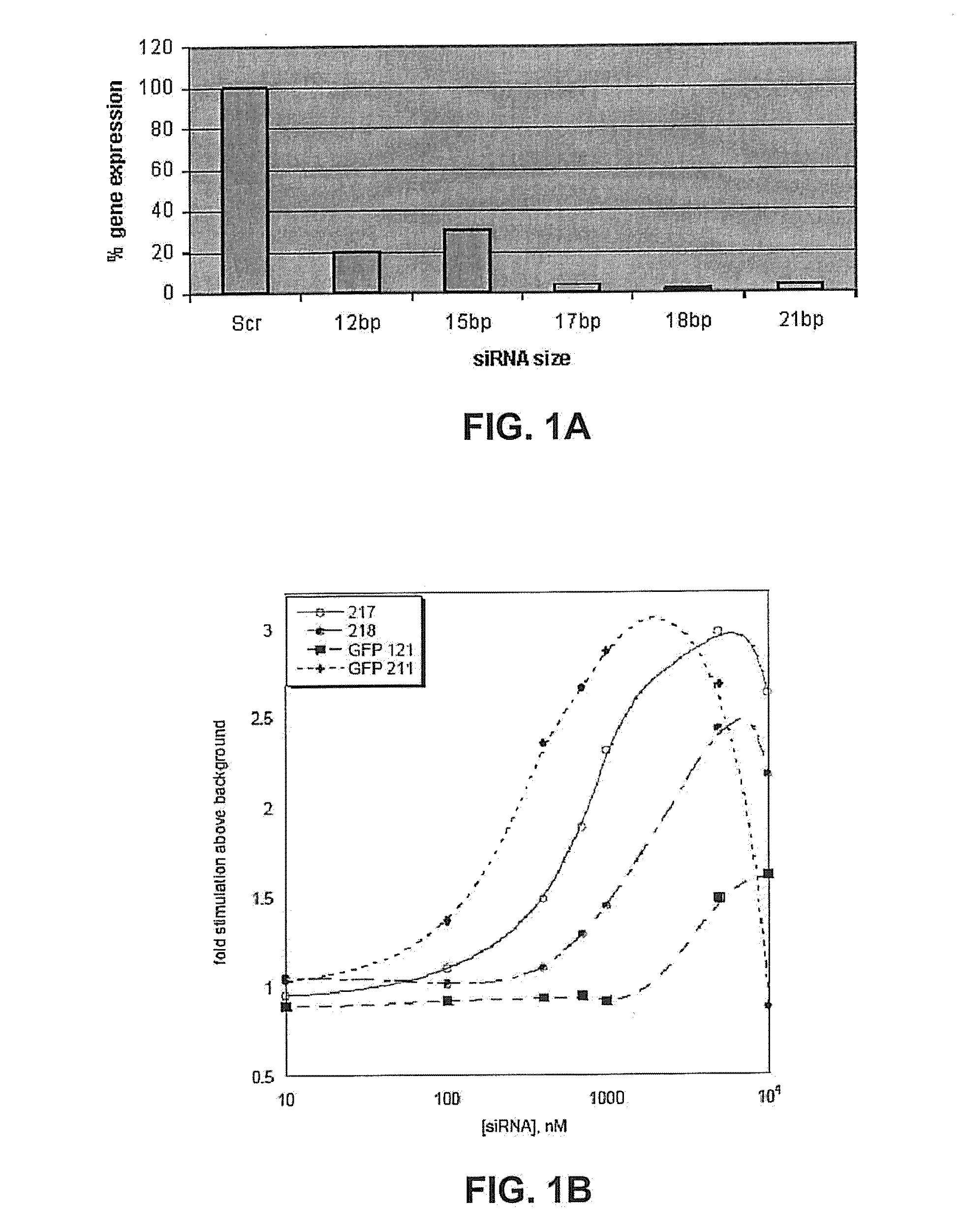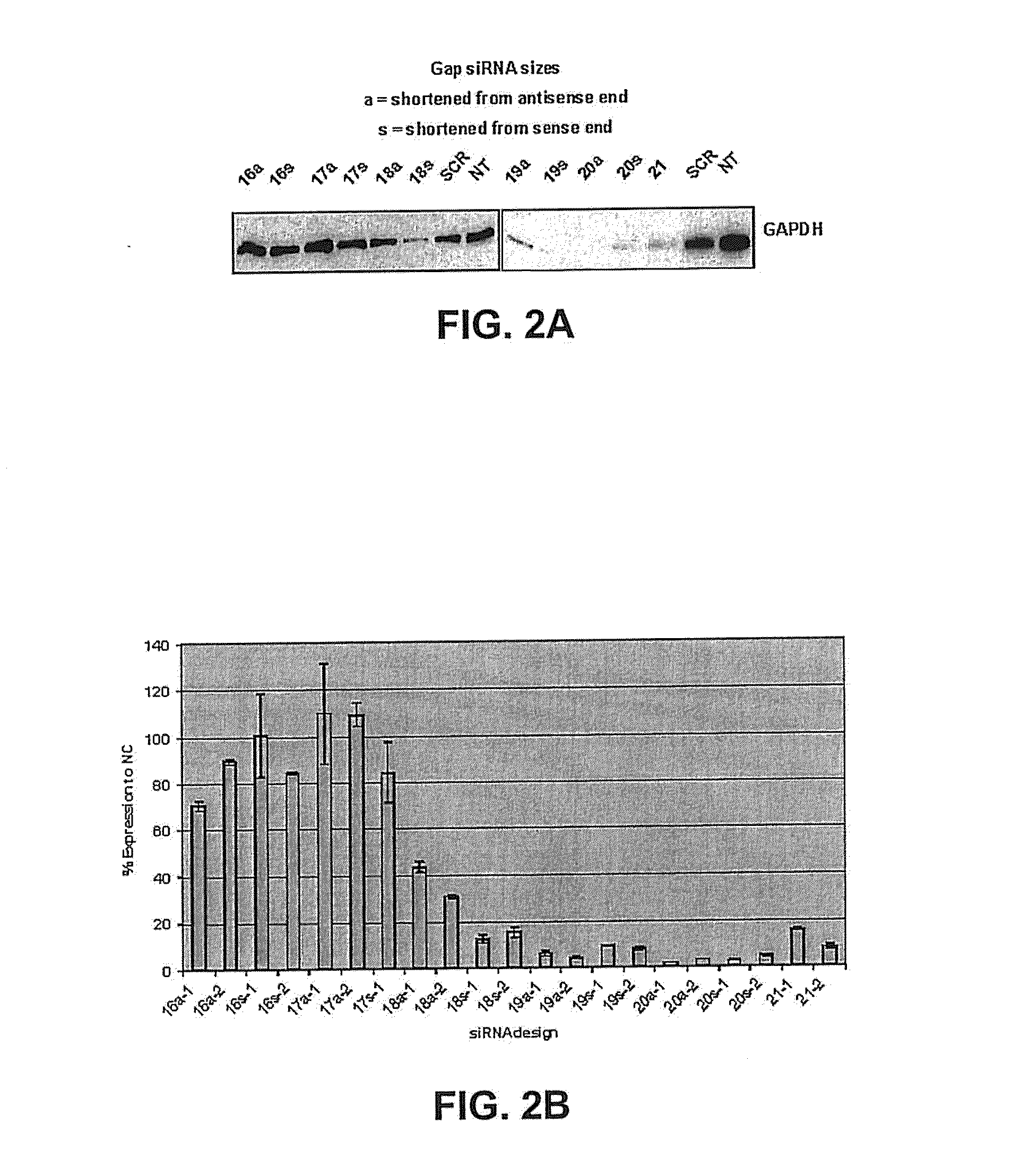METHODS AND COMPOSITIONS CONCERNING siRNA'S AS MEDIATORS OF RNA INTERFERENCE
a technology of sirna and interference, applied in the field of molecular and cellular biology, can solve the problems of difficult purification for in vitro application, difficult to purify, and cumbersome process, and achieve the effect of reducing gene expression and reducing gene expression
- Summary
- Abstract
- Description
- Claims
- Application Information
AI Technical Summary
Benefits of technology
Problems solved by technology
Method used
Image
Examples
example 1
Materials and Methods
[0185]Transfection of GFP siRNAs or a negative control siRNA: Transfection was performed in adherent HeLa cells expressing GFP on glass cover slips in a 24 well dish using siPORT Lipid Reagent. At approximately 24 hours prior to transfection, Hela cells were plated into a 24-well dish at an appropriate density ˜5×104 cells / well in their normal growth media, DMEM / 10% FBS. The cells were incubated at 37° C. overnight in humidified 5% CO2 incubator.
[0186]Formation of a reagent / siRNA complex was performed in a sterile polystyrene 12×75 mm tubes. Dilute 2 ul of siPORT Lipid Reagent was added dropwise into 5.5 μl Opti-MEM® I complexing medium for a 7.5 ul final volume. The final volume was subsequently vortexed thoroughly and then left alone at room temperature for 10 min.
[0187]In each well, dilute 1.25 ul of (20 uM) of chemically synthesized siRNAs was added into 40 ul Opti-MEM® I media. Subsequently, diluted siRNAs was added to diluted siPORT Lipid Reagent, mix by g...
example 2
Chemically Synthesized siRNAs Smaller than 21 by Mediate RNAi
[0196]The inventors designed 12, 15, 17, 18, and 21 base siRNA and tested their potency in silencing GFP (FIG. 1A-FIG. 1B). The inventors synthesized these siRNA's by techniques that are known in the art and discussed throughout the specification. Table 1 includes the nucleic acid sequences of these molecules.
TABLE 1Nucleic Acid Sequence*SEQ ID NO.GFP 12s5′ CAGGAACGCATT 3′1 and 2as5′ TGCGUUCCUGUA 3′GFP 15s5′ GUACAGGAACGCATT 3′3 and 4as5′ UGCGUUCCTGUACAU 3′GFP 17s5′ AUGUACAGGAACGCATT 3′5 and 6as5′ UGCGUUCCUGUACAUAA 3′GFP 18s5′ UAUGUACAGGAACGCATT 3′7 and 8as5′ UGCGUUCCUGUACAUAAC 3′GFP 21s5′ GGUUAUGUACAGGAACGCATT 3′ 9 and 10as5′ UGCGUUCCUGUACAUAACCTT 3′*“s” is sense and “as” is antisense.
[0197]These siRNAs were able to knock down the expression of their target gene (FIG. 1A-FIG. 1B). HeLa cells expressing GFP were transfected with the indicated siRNA and analyzed for the reduction in GFP levels using fluorescent microscope an...
example 3
Chemically Synthesized siRNAs can Silence an Endogenous Gene
[0198]Smaller siRNA molecules targeting GAPDH were also tested to determine if an endogenous gene could be silenced. FIG. 2A-FIG. 2B include data that demonstrates that siRNA smaller than 21 base pairs can knock down endogenous gene expression. These data were obtained by western and real time PCR analysis. The nucleic acid sequences of these smaller siRNAs are listed in Table 2. The inventors synthesized these siRNA's by techniques that are known in the art and discussed throughout the specification.
TABLE 2Last 4 bpLast 4 bpSEQ% GC 5′% GC 5′Nucleic Acid Sequence*ID NO.% GC(as)(s)GAP80 21s5′ GUGGAUAUUGUUGCCAUCATT 3′11 and 12 8 / 21 = 38%¼ = 25%¾ = 75%as3′ TTCACCUAUAACAACGGUAGU 5′OFF FROM 5′ END OF s STRANDGAP80-20s5′ UGGAUAUUGUUGCCAUCATT 3′13 and 14 7 / 20 = 35%¼ = 25% 2 / 4 = 50%as3′ UCACCUAUAACAACGGUAGU 5′GAP80-19s5′ GGAUAUUGUUGCCAUCATT 3′15 and 16 7 / 19 = 37%¼ = 25% 2 / 4 = 50%as3′ CACCUAUAACAACGGUAGU 5′GAP80-18s5′ GAUAUUGUUGCCAU...
PUM
| Property | Measurement | Unit |
|---|---|---|
| homology threshold | aaaaa | aaaaa |
| length | aaaaa | aaaaa |
| concentrations | aaaaa | aaaaa |
Abstract
Description
Claims
Application Information
 Login to View More
Login to View More - R&D
- Intellectual Property
- Life Sciences
- Materials
- Tech Scout
- Unparalleled Data Quality
- Higher Quality Content
- 60% Fewer Hallucinations
Browse by: Latest US Patents, China's latest patents, Technical Efficacy Thesaurus, Application Domain, Technology Topic, Popular Technical Reports.
© 2025 PatSnap. All rights reserved.Legal|Privacy policy|Modern Slavery Act Transparency Statement|Sitemap|About US| Contact US: help@patsnap.com


